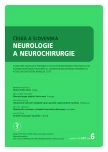Electrophysiological Examination of the Facial Nerve
Authors:
R. Mazanec
Authors‘ workplace:
2. LF UK a FN V Motole, Praha
; Neurologická klinika
Published in:
Cesk Slov Neurol N 2007; 70/103(6): 625-630
Category:
Review Article
Podpořeno: VZ 00064203/6506 a grantem IGA NR/9517-3
Overview
Electrophysiological examination is used to test the motor fibres of the facial nerve and forms part of the diagnostic algorithm for its acute and chronic lesion. The basic test battery consists of direct electrical stimulation, blink reflex, needle EMG and magnetic stimulation. Comprehensive evaluation of the obtained data is necessary to localise the lesions in the peripheral and/or central part of the motor pathways. The examination is important for differential diagnostics of the etiology of the nervous lesion and for a more precise prognosis of the trend in the facial nerve paresis depending on the severity of affection of the nerve. In the case of a chronic lesion, i.e. facial hemispasm, the examination objectivises the paroxysms of involuntary, clonic and synchronous twitches of facial muscles. The tests provide the necessary information for the indication of conservative (rehabilitation) or surgical treatment both at the acute stage and during subsequent conservative therapy.
Key words:
facial nerve palsy – hemispasm – blink reflex – electromyography – magnetic stimulation
Sources
1. Preston DC, Shapiro BE. Facial and trigeminal neuropathy. In : Preston DC, Shapiro BE (Eds). Electromyography and neuromuscular disorders. 2nd ed. Elsevier: Butterworth Heinemann 2005: 375-380.
2. Kimura J. Mononeuropathies and entrapment syndromes. In : Kimura J (Ed). Electrodiagnosis in disease of nerve and muscle.Principles and praktice. 3rd ed. Philadelphia: WB Saunders 1993: 496-498.
3. Liveson JA, Ma DM. Laboratory Reference for Clinical Neurophysiology. Oxford: Oxford University Press 1992: 19-32.
4. Kadaňka Z, Bednařík J, Voháňka S. Praktická elektromyografie. Brno: IDVPZ Brno 1994: 79-80.
5. Rösler KM, Magistris MR, Glocker FX, Kohler A, Deuschl G, Hess CW. Electrophysiological characteristics of lesions in facial palsies of different etiologies. A study using electrical and magnetic stimulation techniques. Electroencephalogr Clinical Neurophysiol 1995; 97: 355-368.
6. Glocker FX, Magistris MR, Rösler KM, Hess CW. Magnetic transcranial and electrical stylomastoidal stimulation of the facial motor pathways in Bell´s palsy: time course and relevance of electrophysiological parameters. Electroencephalogr Clinical Neurophysiol 1994; 93: 113-120.
7. Rösler KM, Jenni WK, Schmid UD, Hess CW. Electrophysiological characterization of pre and postoperative facial nerve function in patients with acoustic neuroma using electrical and magnetic stimulation techniques. Muscle Nerve 1994; 17: 183-191.
8. Valls-Solé J. Electrodiagnostic studies of the facial nerve in peripheral facial palsy and facial spasm. Muscle Nerve 2007; 36: 14-20.
9. Ludin H P. Electromyography in Practice. Stuttgart-New York: Georg Thieme Verlag 1980; 83-85: 130.
Labels
Paediatric neurology Neurosurgery NeurologyArticle was published in
Czech and Slovak Neurology and Neurosurgery

2007 Issue 6
- Memantine Eases Daily Life for Patients and Caregivers
- Metamizole vs. Tramadol in Postoperative Analgesia
- Metamizole at a Glance and in Practice – Effective Non-Opioid Analgesic for All Ages
- Memantine in Dementia Therapy – Current Findings and Possible Future Applications
- Advances in the Treatment of Myasthenia Gravis on the Horizon
Most read in this issue
- Facial Palsy
- Swallowing Disorders Related to Vertebrogenic Dysfunctions
- Antibodies Against Glycoconjugates in the Diagnosis of Autoimmune Neuropathies
- Dercum’s Disease (Lipomatosis Dolorosa) – a Rarely Diagnosed Disease: a Case Study
